Movie Review By: SFAM
Year: 1991
Directed by: Shozin Fukui
Written by: Shozin Fukui
IMDB Reference
Degree of Cyberpunk Visuals: High
Correlation to Cyberpunk Themes: Medium
Key Cast Members:
Pinocchio 964: Hage Suzuki
Himiko: Onn Chan
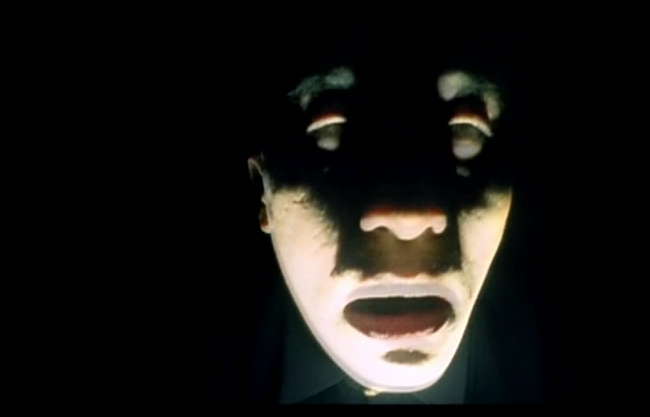
Overview: Back in 1991, Shozin Fukui and crew created a no-budget movie that provided yet another view of Japanese Cyberpunk, one very different from the first Japanese Cyberpunk movie, Tetsuo. In 964 Pinocchio, we don’t get an external merging of man and machine parts – instead, we see the residue of extreme internal struggles – ones that overwhelm the protagonists. The images are very intense, and the pacing is erratic and fast paced. While this movie is uneven and haphazard in places, 964 Pinocchio is definitely a unique experience.

The Story: In this film, 964 Pinocchio (Hage Suzuki) is a strange type of cyborg – someone that used to be human but now has been transformed into a sex slave sold as product. Unfortunately, he no longer “functions” so his owners, a pair of sex-crazed, truly bizarre and sadistic chicks, have thrown him out in the street. Simultaneously, a nurse with a mysterious past, named Himiko (played by Onn Chan), has lost her memory, and she too has been evicted to the streets.

The two outcasts meet up and seem to have a strange attraction to one another. As 964 Pinocchio is essentially a child who seems to have little understanding or awareness of the external world, Himiko takes care of him. She takes him to her living quarters in the basement of a deserted building, and takes him on a food shopping spree where they steal and eat food in the grocery store. Himiko finds out that the corporation that produced Pinocchio is feverishly looking for him, as they are afraid that their illegal process for creating sex slaves will be made public.
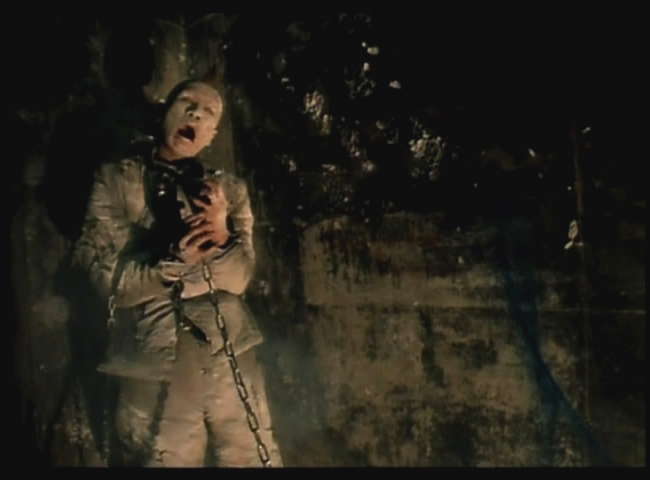
Eventually, 964 Pinocchio starts to gain awareness, and begins to wonder what has happened to him. After becoming frightened and agitated, Himiko calms him down, and then they both realize they have found a “like” soul and then make love (apparently 964 Pinocchio is able to perform when his feelings are re-engaged). Unfortunately, this event unleashes unseen forces inside of 964 Pinocchio – forces that are past the point of control. In short, all hell breaks lose – 964 Pinocchio begins spouting bodily fluids of all kinds and Himiko is thrown against the wall, and finally begins experiencing her own version of the horror. From there, the movie becomes a experiential voyage into the crazed and surreal. The corporation is still after 964 Pinocchio, but they soon discover he is not the same as he once was.

Rubber’s Lover is the Prequel to 964 Pinocchio: Even though it was created 5 years later, Fukia’s Rubber’s Lover is a sequel of sorts to 964 Pinocchio. In this film, we never really understand the process for how Pinocchio was created. Rubber’s Lover gives us a view of this. While the cover for the DVD describes 964 Pinocchio as an android, he’s really not. In fact, he’s virtually all human (although there is a drill to the forehead scene that shows brain matter being removed). If Rubber’s Lover is any guide, he was created by intense sound waves and special chemicals. So at one point he “was” human, but now is “post-human.”

Note to Low Budget Japanese Cyberpunk Film Makers – Use B&W: Because of the low to no budget nature of 964 Pinocchio, the FX are not top quality. While they probably worked better prior to the CG world that we have today, similar to Videodrome, they look very dated in places now. This takes away from the impact of the movie to the point that it just doesn’t really work now unless you put it on a big screen and really crank up the sound. In comparing Tsukamoto’s Tetsuo (a B&W movie) to Tetsuo II: Bodyhammer (a color movie) and Fukui’s Rubber’s Lover (a B&W movie) to 964 Pinocchio, it’s clear that the mood, visuals and ambiance required for Japanese Cyberpunk is FAR better provided by B&W over color. In addition to both Tetsuo and Rubber’s Lover being better movies, they are both FAR more immersive. The low-budget B&W effects don’t detract from the mood, whereas in comparison the color effects look very fake. As an added benefit, shooting in B&W gives the film maker the a critical tool for cyberpunk mood setting: shadows. The use of shadows in a B&W film serve to create a dark, noir feeling which automatically serves up a non-normal mood.
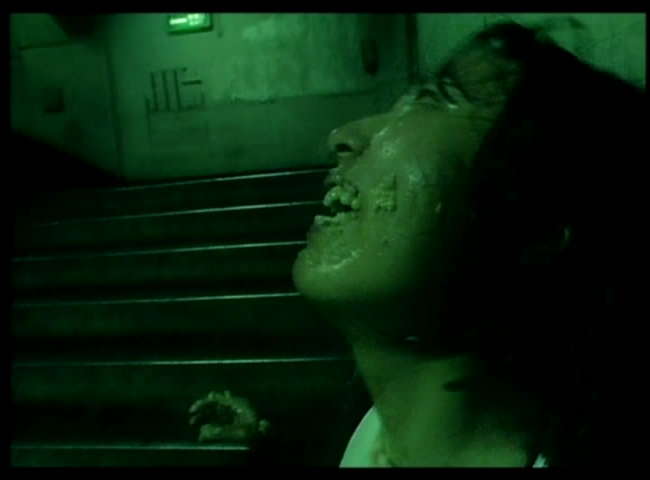
If You Have Vomit Fetish, 964 Pinocchio is For You! Fukui CLEARLY has a vomit fetish, and decides to share it with us in 964 Pinocchio. We’re not talking a wee bit’O vomit coming out - we’re talkin GALLONS worth! Himiko in particular vomits, wipes it on herself, wallows in it, and then eats it all back up! Yummy!

The Bottom Line: 964 Pinocchio is not polished fare, but it does etch out a place in the history of cyberpunk. The story is rather basic, and is really beside the point (many are left confused at the ending – page 2 gives a spoiler understanding if interested). The purpose is to create an immersive mood that details what happens when a dominant power emerges and exceeds human physical capacities. 964 Pinocchio is not for everyone – in fact it’s for a select few. If you aren’t a fan of extreme horror, gruesome imagery, constant screaming, jagged camera work and intense emotions, this movie is probably not for you. If you just want to see a Fukui film, you’re probably better off picking Rubber’s Lover. But if you want an instance of Japanese Cyberpunk in color – the first one in fact – 964 Pinocchio merits a watch.
Page 2: More Intense Screencaps and Spoiler Understanding of the Ending–>
~See movies similar to this one~
Movie Review By: SFAM
Year: 1995
Directed by: Peter Chung & Howard Baker
Written by: Peter Chung et. al.
IMDB Reference
Degree of Cyberpunk Visuals: Very High
Correlation to Cyberpunk Themes: High
Key Cast Members:
Æon Flux: Denise Poirier (voice)
Trevor Goodchild: John Rafter Lee (voice)
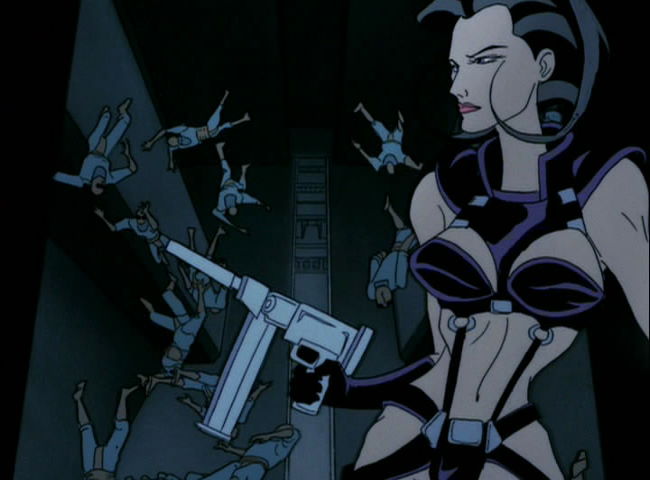
Overview: Aeon-Flux, the brainchild of Peter Chung (also the writer/director of the terrific Animatrix short, “Matriculated”), is one of the really innovative and unique animated shows to come out of the United States. We really have to thank MTV for allowing this show to get produced, and then, after realizing that they just couldn’t control it, for letting it go on unfettered for a second season. Aeon-Flux is not meant to be a coherent whole – this postmodern cyberpunk show is as nihilistic as they come.
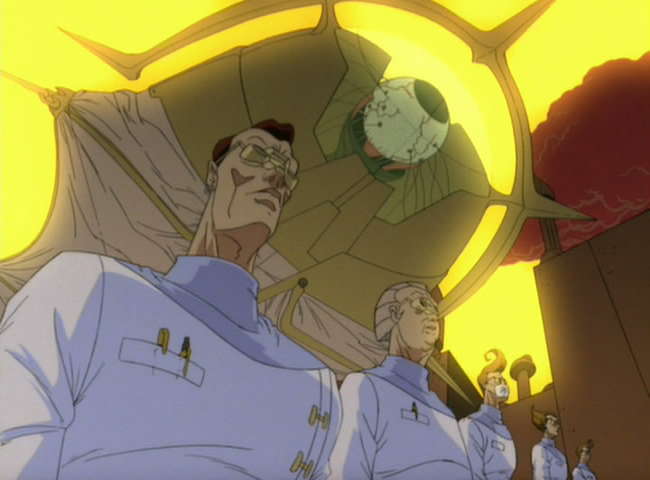
The Story: Aeon Flux takes place in a truly bizarre near-future setting, in which genetic engineering, body modifications, and excessive self-gratification are the norm – yet these extremes take place in a controlled surveillance society. Nearly all events take place in the utopian city, Bregna, which is controlled by a supreme oligarchy. Trevor (voiced by Vampire Hunter D’s John Rafter Lee), one of the two central characters, is a prototypical mad scientist who, at first seems to have little regard for anything other than his own perverted desires. As the show goes on, we find that he is in fact truly besotted with Aeon Flux, who, in many ways is his complete opposite. Aeon Flux (voiced by Denise Poirier) represents the forces of anarchy, and is continually involved in fucking up Trevor’s carefully laid scheming. Unfortunately for Aeon, she too cannot resist Trevor’s guile, which just as often, leads to her downfall.
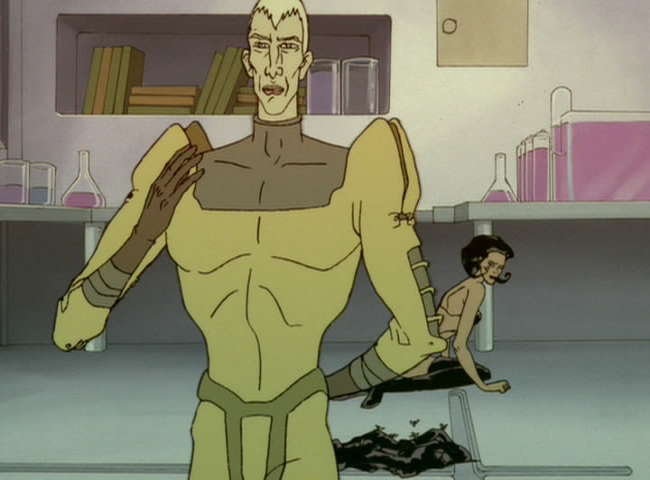
Virtually every episode is different in Aeon Flux, but all of them deal with a strange, fast-paced plot that deals with espionage in some way. Episodes usually have the feel of a chess match, where Aeon and Trevor match wits over completely strange and esoteric plots. More often than not, nobody wins. In fact, unlike most shows, the winning and ending itself is rarely important. This is not what the shows are about. More important is the mood, the feel, and the atmosphere that exudes from the visuals, the dialogue and the score.
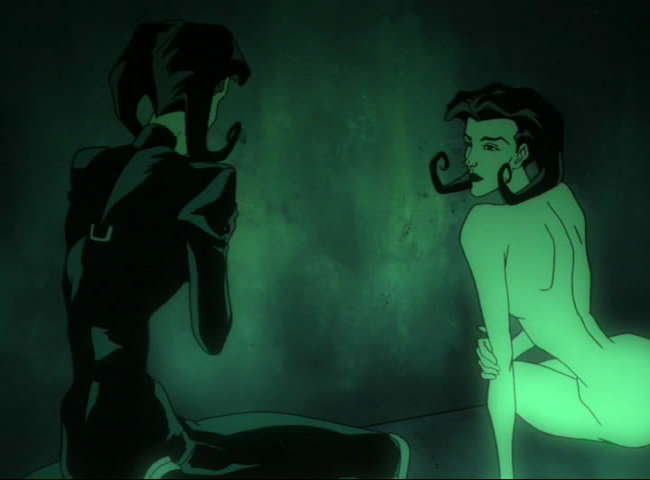
Spoiler – Aeon Flux Dies…A lot! Well, OK, it’s not really a spoiler. It’s more a fact of the show itself. Unlike most shows, in this one, the star dies regularly. Early on in the long shows, Trevor clones Aeon Flux, so thematically, there is now an infinite number of Aeons just waiting to bite the big one. And while there’s now a “rationale” for the deaths, this isn’t really the point – Aeon Flux isn’t meant to hold together that way. It’s almost as if each episode is completely it’s own show. But if she dies, rest assured it will happen in a truly innovative and gruesome way. It could be drowning in a vat of poisen, getting dropped out of a plane, being eating by bizarre genetically modified creatures, or, well, you get the idea. .

Aeon Flux – the Ultimate Anti-heroine? In many ways, Aeon Flux comes across as the ultimate anti-heroine. While she clearly knows right from wrong, and generally tries to stop the worst abuses, Aeon is an ultra-acrobatic, top-notch action/espionage heroine who works for herself. She’s just as likely to take an assassination job as she is to stop a horrid virus from killing mankind. Did I mention she’s drawn up in ultra-hot, skimpy clothes, and likes to have sex a lot? In this way, she really does qualify as a more female than female character (usually cyberpunk reserves these for cyborgs and androids). Most interestingly, because of Aeon Flux’s propensity for dying, you never know whether or not she’s going to make it through alive, or even whether she’ll complete her mission (she seems to fail almost as much as she succeeds). This really does add an excitement to the episodes.

The Love-Hate Relationship: Aeon-Flux and Trevor have a complete love-hate relationship. Even when they are bent on killing one-another, there is always sexual tension, which while often consummated, never leaves the two characters. Every episode gives us yet another chance to explore their relationship in a completely bizarre way. Trevor is definitely Aeon’s Kryptonite. More often than not, his presence alone is enough to make her botch her mission. However, this doesn’t stop Aeon from ruining most, if not all of Trevor’s take over the world plots.
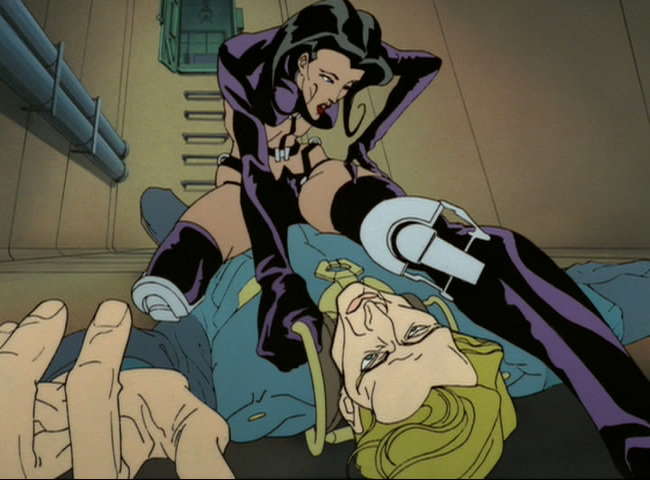
The Visuals and Cinematography: Aeon Flux gives a number of different looks as the show progresses. Perhaps my favorite are the perspective shots such as the one above. We also get lots of wide angle shots, strange close-ups, gradients, and a number of truly surrealistic sets. Unlike most cyberpunk, Aeon Flux doesn’t really adhere to a single dominating color scheme – but to the extent it does, the blues are more highlighted than the rest. Usually, each episode will have a unique theme that dictates the color choices – often they will take a color palette (oranges, greens, etc.) and detail it out in interesting ways. Some episodes are truly surreal in nature, while others are straight neo-noir. The overall goal is always to innovatively create a far-out intense atmosphere wrapped up in a tightly paced, no-nonsense near-future espionage show. More often than not it succeeds.
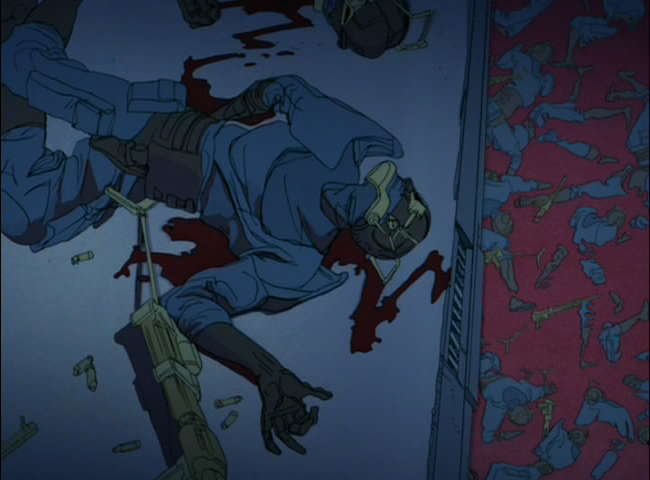
The Violence: Much to MTV’s initial chagrin, Aeon Flux is NOT a kids show. This is an adult cartoon in every way possible, including the intense violence. While the shorts are more violent than the half-hour episodes, Aeon Flux is consistently violent. There are leg amputations, deaths by gunshot, poison, insects, creatures, aliens, viruses, et cetera (often to Aeon herself!). Blood and gore are often just a scene or two away. All of this serves to strengthen the near-future but otherworldly atmosphere of Aeon Flux.
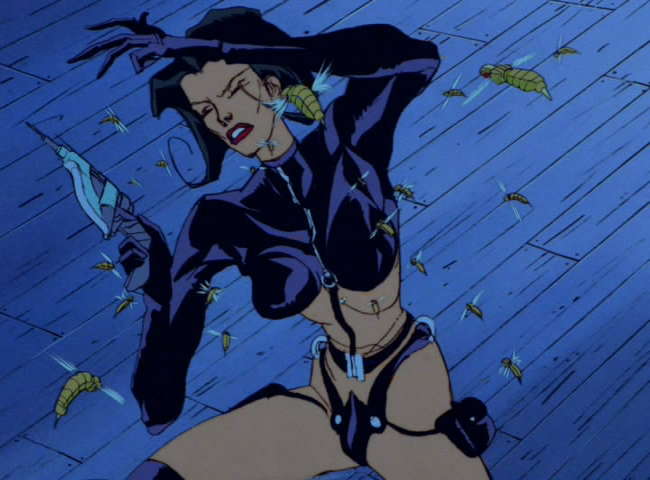
The Gadgets: Aeon-Flux is filled with gadgets of all flavors. Most common are body modifications and “biopunk” elements (just learned that word ). Body modifications include external spinal cord implants, leg jumping implants, conversions of limbs, eye implants, and various compartmentalized bodily storage areas. Genetic engineering is a huge theme in Aeon Flux, far more than the cyber-aspects. We also see repeated instances of cybernetically modified insects who’s function is to inflict a virus of some kind into a target population (Now we know where DARPA got the idea from!). Needles are also a recurring them, and show up everywhere from guns, to security implements, to, um, the operating table.
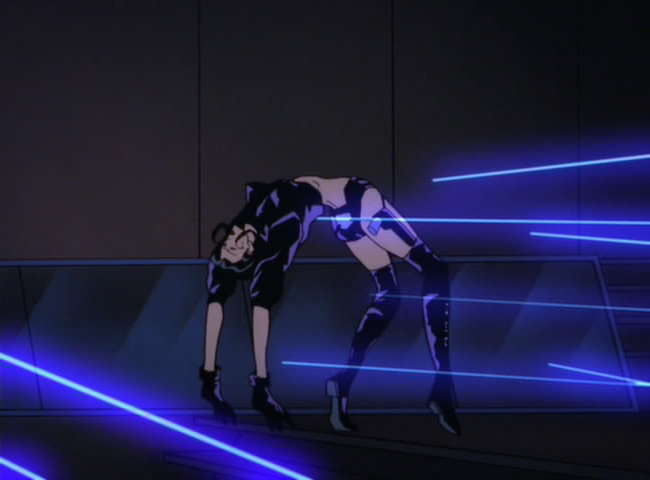
The Bottom Line: Aeon Flux is one of the really creative shows to come out of United States Television. This show validates the purpose of cable TV – we get to see talented folks like Peter Chung let lose their creative energies to produce something truly unique. And while I normally don’t spend too much time talking about the DVD features, I must on Aeon-Flux – the DVD set is flat-out terrific. I almost put it up there with Errol Flynn’s Robin Hood and The Kino edition of Metropolis as one of my favorite DVD productions of a long-lost show. The commentaries, featurettes, and extras are all terrific on the Aeon Flux DVD. If I had any qualms about whether to give Aeon Flux 8 or 9 stars, the incredible quality of the DVD set answers it for me.
More Aeon Flux Screencaps on Page 2–>>
~See movies similar to this one~
Year: 2004
Directed by: Masahiko Maesawa
Written by: Chinfa Kang
IMDB Reference
Degree of Cyberpunk Visuals: Medium
Correlation to Cyberpunk Themes: Low
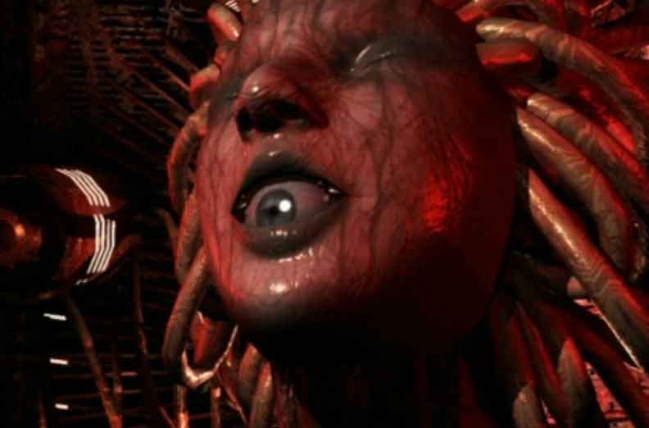
Overview: Galerians Rion is a a low-quality animation - meaning video game quality with a semi-coherent story. Unfortunately, the story too plays like a video game. The star of the video game is a boy named Rion, who wakes up in a bizarre dystopic version of his former world. It turns out that this crazed supercomputer named Dorothy is attempting to become a God and only Rion can stop her. To do so, he needs to find his sister Lilia, who, along with Rion, has been given a virus that combined, can destroy Dorothy. As most RPGs, Rion’s powers grow as he fights the Galerians that Dorothy throws up to block his journey to finding his sister. You can tell the end of the segment, because, um, Rion fights a boss character. Yes, you really are watching someone play a video game here!
The Bottom Line: While I am impressed that Maesawa was able to produce an anime on such a limited budget (I’m guessing a game environment was used to make most of the visuals other than Dorothy), they just aren’t good enough to make for compelling viewing. The visuals are rather fascinating in places - Dorothy (see above) is pretty cool for instance - and certainly are cyberpunk, as is the story, but there just isn’t enough here, either in story or visuals to make this worth recommending. I will give it a point for attempting to do a full scale anime without a budget.
~See movies similar to this one~
Year: 1996
Directed by: Shozin Fukui
Written by: Shozin Fukui
IMDB Reference
Degree of Cyberpunk Visuals: High
Correlation to Cyberpunk Themes: Medium
Key Cast Members:
Kiku: Nao
Shimika: Youta Kawase

Rectal injection for instant effect!
Overview: Rubber’s Lover is one of the truly bizarre Japanese cyberpunk films. Rubber’s Lover is an extreme cyberpunk movie that includes a number of truly outlandish violence and sex scenes. Fukui’s entire message here is summed up well on his interview on the DVD, “Dominant power comes when mental anguish exceeds physical tolerance.” Truly, this is what this movie is about. Chances are, for most of you, this movie will be pretty much completely different from anything you’ve ever seen - which is reason enough to watch it.
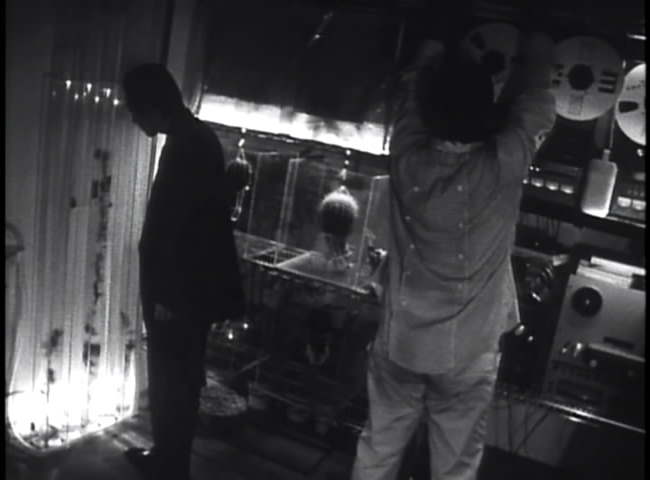
The story concerns three scientists who are attempting to create psychic powers in their test subjects. They use a combination of customized psychotropic drugs and extreme sound wave patterns engineered to torture their test subjects into unimagined mental states in the hopes of surpassing their normal mental abilities. Unfortunately, their test subjects have a tendency to die gruesome deaths by exploding blood everywhere. The corporation funding the research has decided to pull the plug, and have sent Kiku, a low ranking finance employee (who is about to quit to marry the head manager) to relay the news. Two of the scientists go mad and decide to administer the torture treatment to the third scientist, Shimika, as their last hope for developing psychic powers. When Kiku she discovers their torture chamber, one of the scientists abducts and rapes her, and then includes her as a test subject. Shimika and Kiku join forces and try to escape but are captured again and are then subjected to extreme torture in hopes of increasing the speed of success.
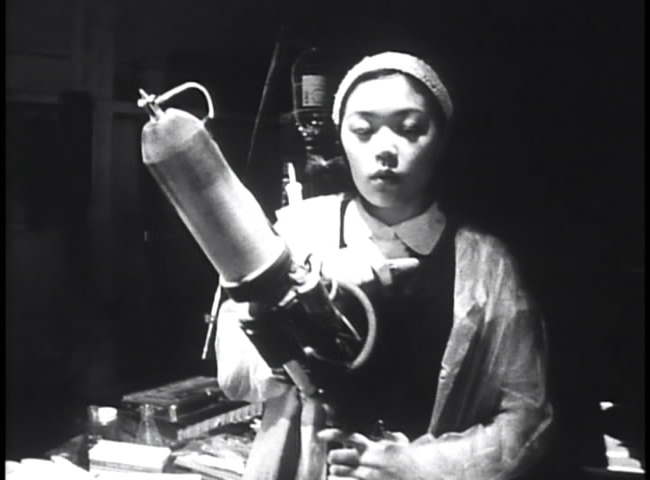
Unfortunately for the scientists, they are successful. During the infamous “rubber suit” treatment, Shimika exhibits massive psychic abilities – so much so that he no longer needs the equipment to mentally attack his captors. There are various side characters in this including Kiki’s corporate slimebag fiancé, and an assistant chick who has a penchant for slapping test subjects.

The Visuals: The entire movie takes place in a few rooms, and from this perspective, its pretty amazing how realistic and unique a film can be made on such a small budget. The shots seem very well designed to make maximal use out of very meager special effects. Massive quantities of dry ice, blood and screaming make up the bulk of the visuals, but this ends up working in black and white. But what Rubber’s Lover gives you is an ever increasingly insane set of scenes. Whether or not you follow the meager plot, you’ll see some truly bizarre scenes. The weirdest has to be the sex scene near the end where the guy orgasms while ripping the screaming woman’s chest open while he’s watched by the laughing corporate slimebag.
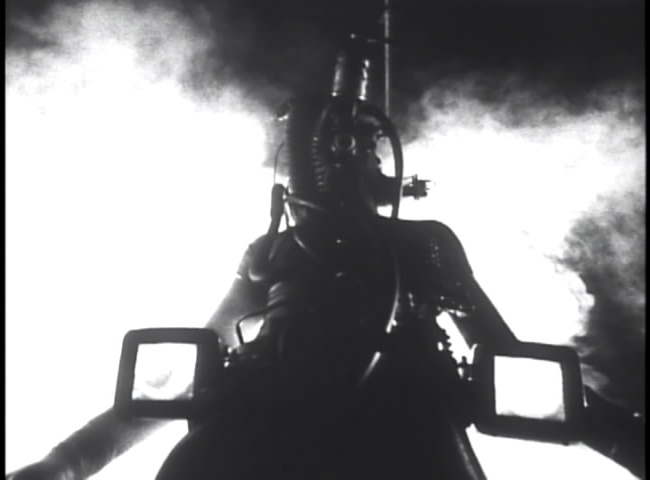
The Bottom Line: If you’re looking for a Japanese Cyberpunk flick that gives you something different then Tetsuo, Rubber’s Lover is a decent choice. It doesn’t have the deep philosophical message that Tetsuo does, but the cinematography and crafting is done well enough that you will get the sense you are watching an art film versus a purely bizarre sequence of violent images. Truly, Fukui put out a far better film than one would expect given an almost non-existant budget. I had taken a point away for the constant screaming, which began to detract from the film after a while, but I finally decided this is sort of necessary screaming (mostly). All in all, Rubber’s Lover is well worth watching if you’re interested in understanding Japanese Cyberpunk as a sub-genre. Check out page 2 if you want to see more visuals - WARNING - some are explicit.
Page 2: More Screencaps –>>
~See movies similar to this one~
Tags: cyberpunk movie review RubbersLover
Year: 1982
Directed by: Slava Tsukerman
Written by: Anne Carlisle, Nina V. Kerova & Slava Tsukerman
IMDB Reference
Degree of Cyberpunk Visuals: Medium
Correlation to Cyberpunk Themes: Very Low
Key Cast Members:
Margaret/Jimmy: Anne Carlisle
Johann Hoffman the Scientist: Otto von Wernherr
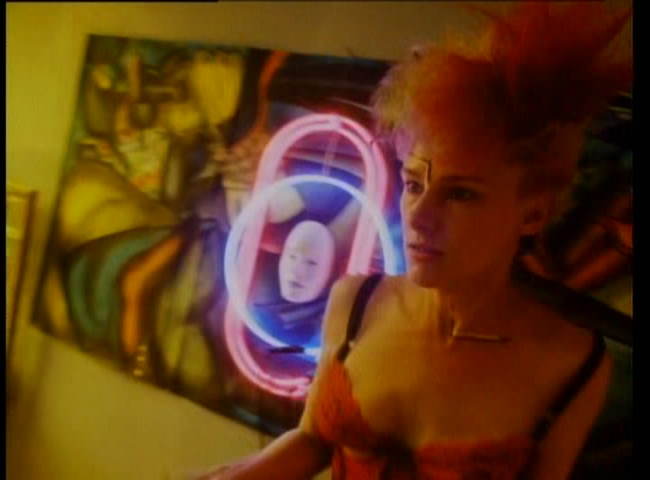
Overview: Liquid Sky is another movie that makes a number of cyberpunk lists. Personally, I don’t think so. It has absolutely NO cyber aspects (it does have scifi aspects though). However, it’s so strong on the punk side that from a visual standpoint I suppose a case can be made for inclusion. This is a very low-budget art film that is emphasizes “weird” from the get go. If I were to rename it, I would call this “The movie where the Punks say Fuck!” as they do so every other word. The real effort here is NOT in the acting (most is horrible, but Carlisle is decent), or the story, or the pacing. The goal is to create a weird punk immersion that gives the film an other-worldly quality. This is emphasized by the completely non-sensical alien pie-plate spaceship.
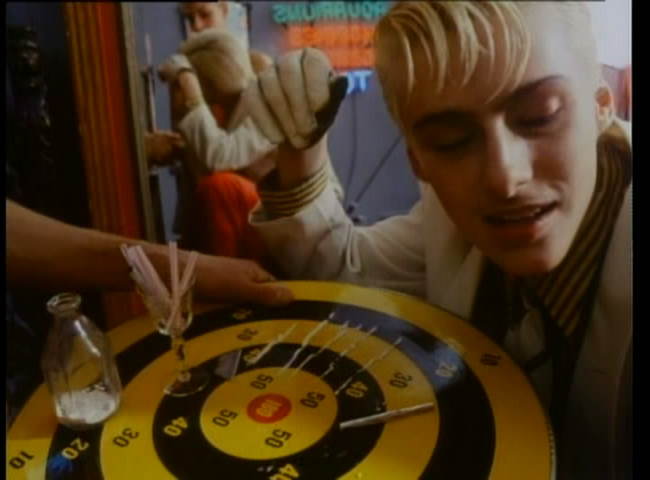
Liquid Sky takes place in modern times (early 1980s) where a very small alien space ship is looking for a heroin fix and settles on top of a punk-apartment building where drug addicts are the order of the moment. The space ship “steals” the emotional state of the heroin addicts to give itself energy. We soon find out that the aliens can also get their fix from people having orgasms. In line with this, the aliens follow around Margaret (played by Liquid Sky writer, Anne Carlisle, who also plays the role of the androgynous Jimmy in the picture above), who is continually getting raped and forced into having sex with people she doesn’t like. She never orgasms, but her partners always do. At first, the aliens appear to steal this energy by impaling the victims with a crystal scepter, but later, the victims just disappear. Anne starts to think her vagina has the power to kill, and either tries to stop having sex with people she likes (which fails) or seeks out those she hates in order to kill them. All the while, a European scientist, who’s big on the narration (this is the only way we learn what’s going on) is tracking down the alien ship and is attempting to warn the punks.
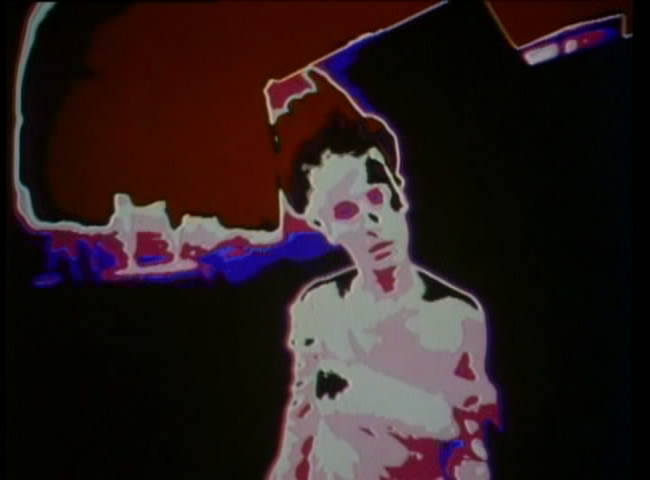
Overview: This movie is a massive cheesefest in every sense of the word. It is quirky enough to be interesting though (hence the 5 stars instead of 4), and is certainly original to the point that I could certainly imagine some enjoying this multiple times. Again, for the moment I’ve decided to include it as a cyberpunk flick, but I’m sorely tempted to move it to the “not cyberpunk” category. Even though the visuals qualify in a strange way, there is no cyberpunk themes to speak of here.
~See movies similar to this one~
Tags: cyberpunk movie review LiquidSky
Year: 2003
Directed by: Jun-hwan Jeong
Written by: Jun-hwan Jeong
IMDB Reference
Degree of Cyberpunk Visuals: Very High
Correlation to Cyberpunk Themes: Medium
Key Cast Members:
Lee Byeong-gu: Ha-kyun Shin
Kang Man-shik: Yun-shik Baek
Su-ni: Jeong-min Hwang
Inspector Choo: Jae-yong Lee
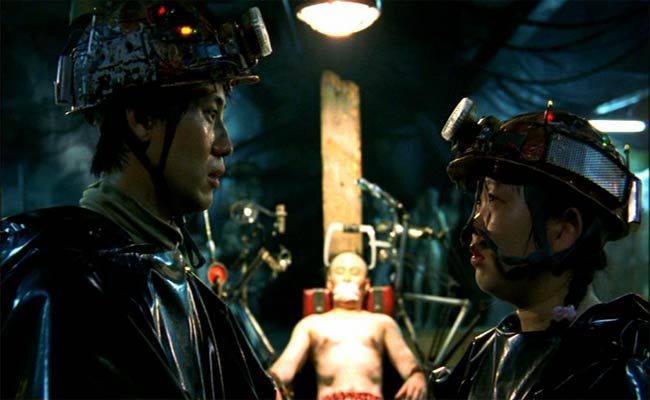
Overview: Here’s another movie that ranks really high on the weird shitometer scale - yet another cyberpunk movie from the tour-de-force of cyberpunk movies that Korea has become. Save the Green Planet is one of the only movies that has just about every movie genre represented. You’ll find everything from Gilliam-like comedy to graphic horror, to action, to scifi-thriller here. And of course, we get a large dose of Japanese-like Cyberpunk torture visuals in this terrific Korean production.

The Story: Save the Green Planet is about a completely strange guy and his even wierder ballerina girlfriend - our antihero is convinced that a certain CEO is really an alien in disguise. He has determined its his job to root the alien out and kill him if necessary, just like all the other “potential” aliens he has found in the past. After capturing him, He cuts the CEO’s hair off, as the aliens use hair follicles to communicate. He has other reasons for requiring foot torture and chest ironing. After all, good torture must always have a reason, right?
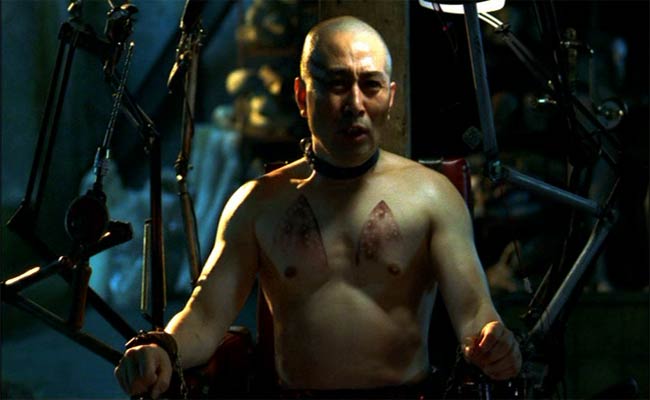
The Bottom Line: Its hard to go too much further into the plot for fear of giving key aspects of the movie away. Suffice to say the ending is terrific and fully open to interpretation, and actually has interesting similarities to the ending of Brazil. On top of this, Save the Green Planet is expertly shot, and wonderfully edited. The pacing is simply superb. It’s really hard to imagine that this is Jun-hwan Jeong’s first movie.
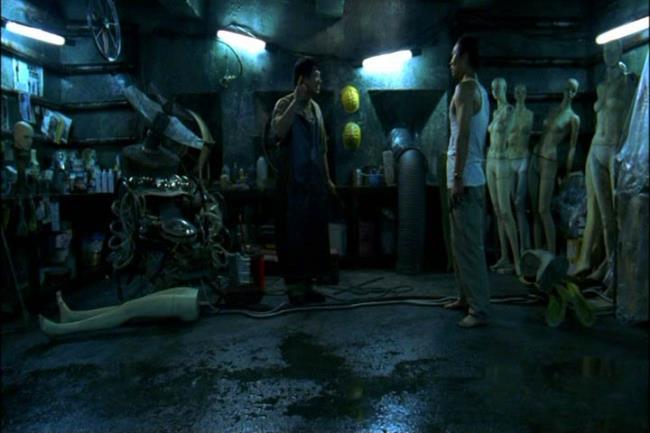
You gotta love the dolls everywhere. This guy makes them for his job.
Fair warning: Be warned though. This is a truly weird movie that his NOT for the squeemish at heart. While not a “true” Japanese cyberpunk movie in that, um, its Korean, and doesn’t totally take the “no boundaries” idea, it’s pretty darn close, and certainly merits mention in that sub-genre of cyberpunk. So much so that if you find real Japanese cyberpunk movies to be too much for you (And BTW, Tetsuo 2 doesn’t count, as this movie really doesn’t break ground and isn’t that good besides), Save the Green Planet is a decent entry to at least experience a similar pacing and mindset. Got to Page 2 for more screen caps.

Page 2: More Screen Caps–>>
~See movies similar to this one~
Tags: cyberpunk movie review Jigureul jikyeora
Year: 2000
Directed by: Shu Lea Cheang
Written by: Shu Lea Cheang
IMDB Reference
Degree of Cyberpunk Visuals: High
Correlation to Cyberpunk Themes: Medium
Key Cast Members:
Tokyo Rose: Aja

Overview: If you’ve been hankerin for a nice quality ultra-surrealistic medium-core porn Japanese cyberpunk flick, then look no further than I.K.U. Japanese cyberpunk movies are all about no boundaries and I.K.U. takes this notion to heart, coming up high on the wierd shitometer scale. For the soft-core goods, you get a bit of everything here: guy-on-girl, guy-on-guy, girl-on-girl, girl-on-transgender, voyeuristic sex through a fish tank while eating sushi, sex in a spider-web…well, you get the idea. And while if what you’re looking for is naked body parts, I.K.U. definitely delivers (some cases its pixelated out, but in most cases its definitely NOT pixelated out, even when you wish it was…). Fair warning though - this is NOT a “take care of yourself” type movie, as you will spend most of the time dumbfounded while watching it. I.K.U is an EXTREMELY strange, but well-done mind-fuck, pure and simple.

I.K.U. takes place in a very strange near-future Japan and follows a day in the life of a sex-roid from the GENOM corporation, who has the ability to change her outside shape to mimic different female body types. Her job is to collect “sexual experiences” by engaging in sexual acts with various people. The experiences are collected in order to produce virtual reality-like I.K.U. chips that are then sold in vending machines. The idea is that people can buy the chips and then “wire in” on the sexual encounter. Unfortunately, a rival corporation has developed rival androids who’s job is to insert a virus into the sex-droids and steal their “experiences” so that it can make its own rival chips.
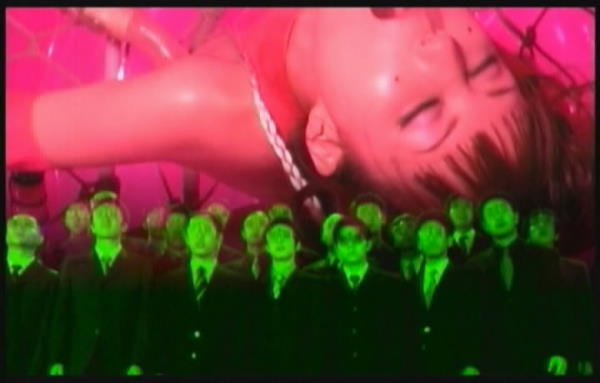
But truly, the story is not the reason you get this. In fact, the visuals distract you so much from the story that I strong recommend reading the story bits on the extras prior to watching this film. The reason you watch this is for the extremely weird but interesting set designs and cinematography. Every “vignette” offers some truly interesting cyberpunk visuals. Shocking neon is the order of the day here. Shocking “you” is the point of the film.
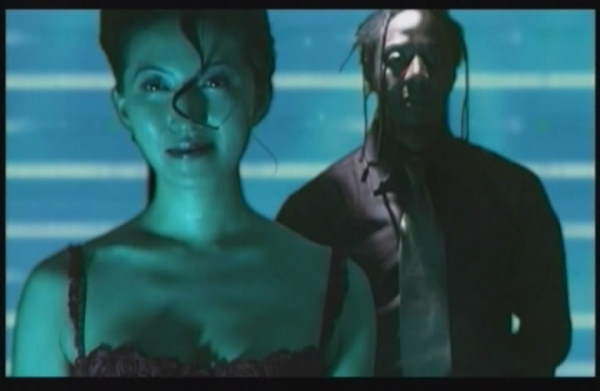
The Bottom Line: If you’re a “no boundaries” kind of film watcher, and are interested in something WAY off the beaten path, give I.K.U. a try. Just to be clear, I.K.U. opened at the Sundance Film Festival, so again, this is not your average skin flick - this is an artsy skin flick. And honestly, rating this film is a complete waste of time, as I really have nothing to compare it to (I’m giving it a 6, just because…).
PS - one word of caution - the guy-on-guy oral sex scene is one that is NOT pixelated out, nor is the scene with the transgender (I think that’s what he is…a guy with an “in-between” part). Both only last for a few seconds or two, but are QUITE graphic if you get my drift…

Again, I could go on, but truly, commentary is a waste of time on a flick like this. What you need to evaluate whether you want to see this or not are screen captures. On to Page 2 of this review if you are so inclined. Fair warning - while I worked hard not to show any body parts, page 2 is clearly meant for adults.
Page 2: Screencaps–>>
~See movies similar to this one~
Year: 1998
Directed by: Ryutaro Nakamura
Written by: Chiaki Konaka
IMDB Reference
Degree of Cyberpunk Visuals: High
Correlation to Cyberpunk Themes: Very High
Key Cast Members:
Lain Iwakura: Kaori Shimizu

Overview: Serial Experiments Lain is a psychedelic, post-modern cyberpunk series that one wonders how the director ever managed to make. Lain centers on a very shy school girl who slowly begins to figure out that she is not what she seems to be. After getting a computer and connecting to the “wired,” something with is far more expansive than the internet, Lain begins to realize that she may not be human, and that truly, reality and the “self” is exists (or does not exist) on many different levels. As the story progresses, Lain “evolves” in terms of understanding what she is and her place in a very post-modern world. We also get many interesting side stories, including crime, teenage coming of age issues, and dastardly plots.

The pacing of Lain is just strange. Lain is NOT an action fest, nor is it by any means straight forward. Lain starts out rather slowly and gets weirder every episode. Truly, the story is told in a very “traditional” post-modern fashion in that we have fragmented vignettes structured in a seemingly random non-linear manner. Lain uses disconnected visuals to continually barrage the viewer with different textures, color schemes, and sounds. Yet over time, it becomes clear that the story is being spunk in seemingly a cyclical fashion, almost as if we are exploring a large Mandelbrot by starting at an outside spiral and slowly working our way around to the big picture. Each fragmented vignette gets added to until, at the end, we have a rather expansive tapestry to explore.

Many different and interesting philosophical ideas. But it is pure philosophical cyberpunk. Many key issues are discussed here, including:
- What constitutes “reality”?
- How real is time?
- What constitutes the “self” as a singular entity?
- What constitutes “God”?
- How are sentient programs different from humans?
- Is there such a thing as collective humanity?
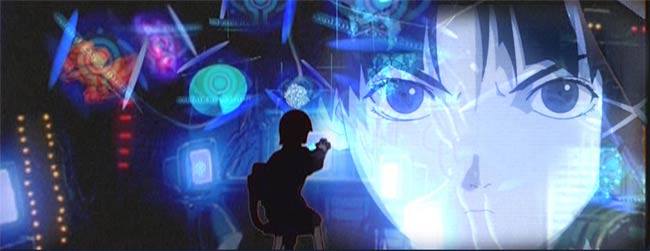
The visuals in Lain really aren’t there to “Wow” us as they are in some animes - instead they are often designed to provoke moods and thought patterns (BTW, there are so many screen caps available, that there was no need to take my own). Among the thought provoking visuals, we get:
- Psychedelic visions that explore multiple “selves” versus a singular “I”
- Juxtapositions of noise with false clarity
- Information Theory described visually
- An ever increasing feeling “disbelievability” each time the drab and normal school scene is shown.
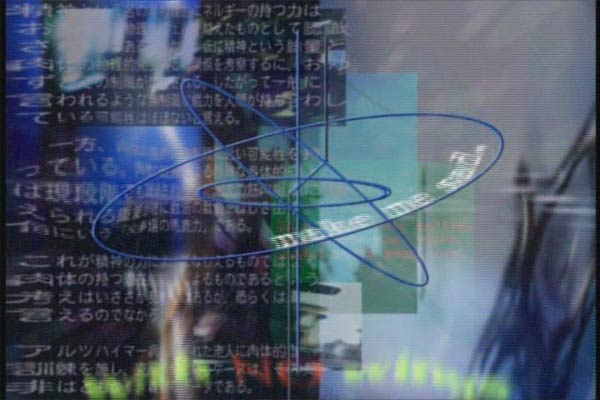
The Bottom Line: In the end, we are left with very open-ended thoughts. Serial Experiments Lain does not provide us with answers, instead, it opens us up to questions. And while I might argue that the post-modern pacing got too circular in places, and that I might argue the same tale could have been spun in half the time, the overall effect is rather extraordinary.

~See movies similar to this one~
Tags: cyberpunk movie review anime Serial Experiments Lain
Year: 1995
Directed by: Terry Gilliam
Written by: Chris Marker, David & Janet Peoples (screenplay),
IMDB Reference
Degree of Cyberpunk Visuals: Very High
Correlation to Cyberpunk Themes: Very High
Key Cast Members:
James Cole: Bruce Willis
Kathryn Railly: Madeleine Stowe
Jeffrey Goines: Brad Pitt
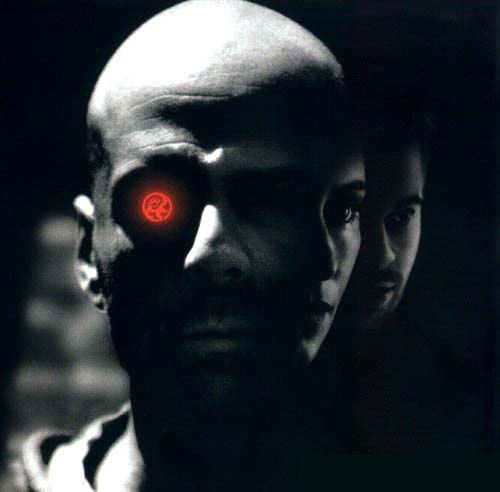
Overview:Twelve Monkeys is yet another tour-de-force from film maker Terry Gilliam. Done as a remake to the very innovative experimental French film, La Jetée, Gilliam is able to take the same notions of time travel, dystopic futures and personal trauma and love, and wrap it into a truly riviting package.
Because of the similarities, I have reviewed this movie in-depth in combination with La Jetée (these two movies truly go together). Please check it out:
~See movies similar to this one~
Tags: cyberpunk movie review
Year: 1962
Directed by: Chris Marker
Written by: Chris Marker
IMDB Reference
Degree of Cyberpunk Visuals: High
Correlation to Cyberpunk Themes: Very High
Key Cast Members:
Narrator: Jean Négroni
The Man: Davos Hanich
The Woman: Hélène Chatelain
The Experimenter: Jacques Ledoux

Overview:La Jetée as a movie is one of the most interesting I’ve encountered. Virtually the whole movie involves narrating still shots. While this sounds like a glorified slideshow, its anything but. The pacing is magnificent. The mood created is truly immersive. In a truly astounding feat, Marker traps the viewer in this "slide show" mentality, and then, as the movie is discussing whether the character can decipher what’s real or not, he pulls the run out from under us.
I have reviewed this movie in-depth in combination with 12 Monkeys (these two movies truly go together). Please check it out:
~See movies similar to this one~
Tags: cyberpunk movie review
|

















































